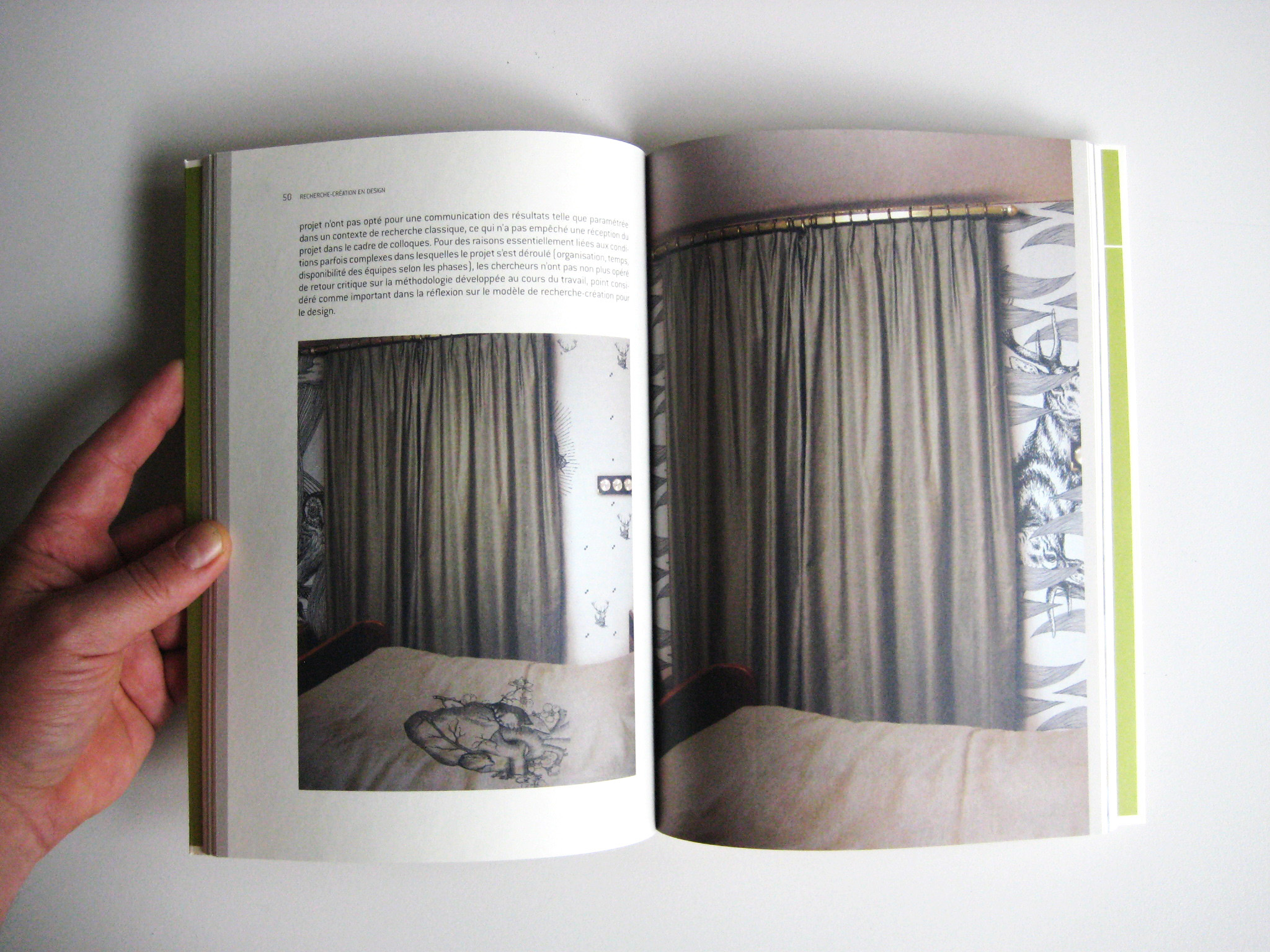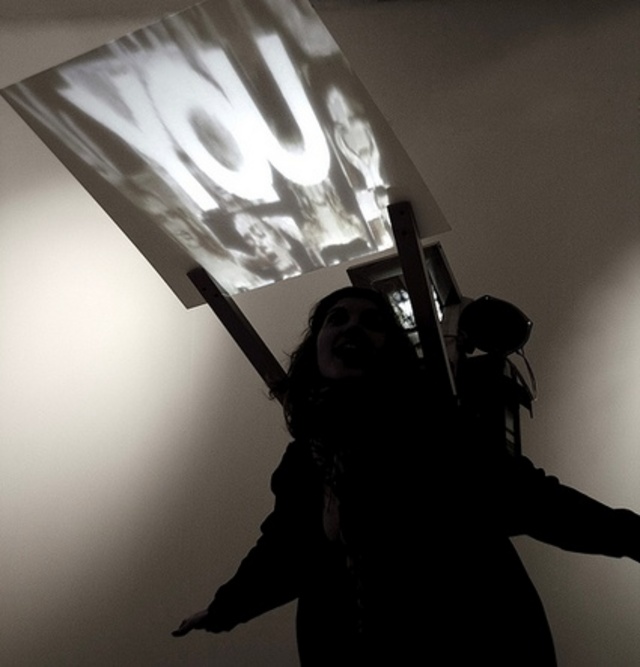Tuesday, February 15. 2011
Translated By
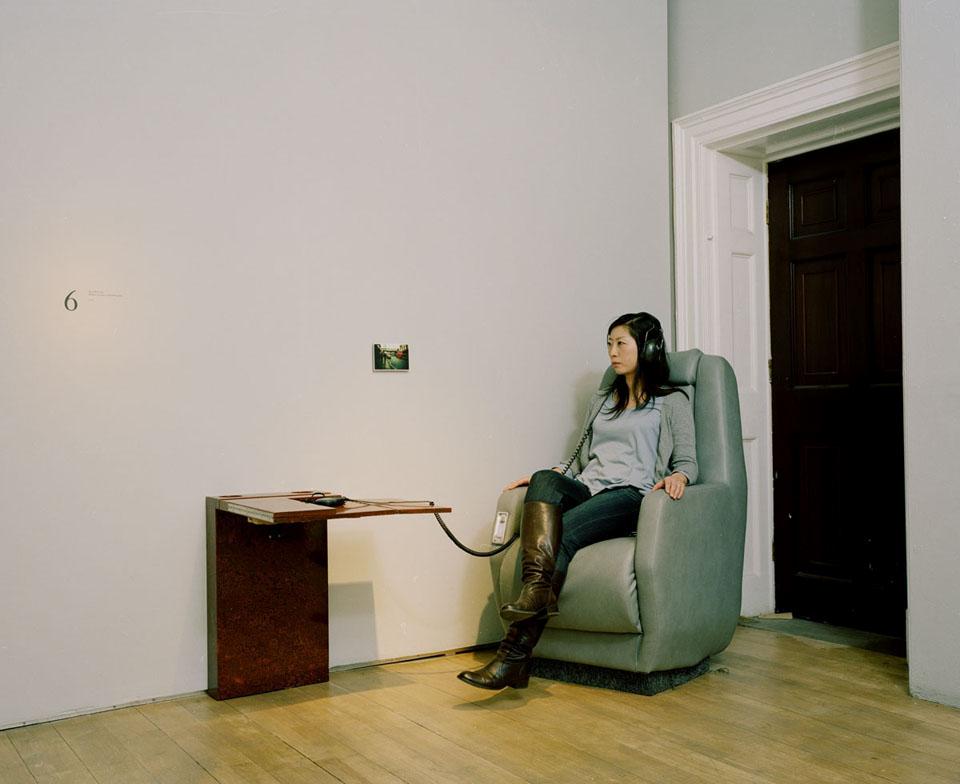
At the Architectural Association, 11 writers and 11 literary places are the subject of an immaterial translation – via the voice
The walls of latest exhibition at London's Architectural Association gallery are painted a muted grey. There are 11 large-ish white numbers placed carefully around the room and small postcards next to the numbers. There seem to be various kinds of chairs or seats everywhere. But, as someone hands over the props of the standard exhibition audio tour, a heavy-duty pair of headphones and what looks like an audio guide, it becomes clear that the exhibition doesn't take place in this room. It is not a visual experience at all.
The show is a kind of audio mix-tape of fictional and real places written by eleven international authors, including Douglas Coupland, Rana Dasgupta, Hu Fang, Julien Gracq, Tom McCarthy, Guy Mannes Abbott, Sophia Al Maria, Hisham Matar and Neal Stephenson. These vivid short stories or extracts are spoken by actors and last around ten minutes, variously traversing landscapes from Ramallah to turn-of-the-century Sofia, a cold, dead Vancouver to a dusty checkpoint in Palestine. Each of the authors sent a small picture postcard – a trigger image – which holds the listeners' attention.
The exhibition doesn't happen in the room or on the seats – it takes place between the spongy cushion of the headphone and the visitor's ear. Next to the bar at London's Architectural Association, the show's curators Shumon Basar and Charles Arsène Henry discuss the concepts and processes that went into making a show, without a show.
(...)
More about it HERE.
Related Links:
Monday, May 31. 2010
"Patrick Keller & Christophe Guignard", Recherche-Création en Design (ed. L. Léchot-Hirt), Métis Press (Genève, 2010) | #recherche #création #académique
Tuesday, April 06. 2010
Ice Cream Climatology
 [Image: The Cloud Project van by Zoe Papadopoulou and Cathrine Kramer].
[Image: The Cloud Project van by Zoe Papadopoulou and Cathrine Kramer].Like a whimsical hybrid of molecular gastronomy and Glacier/Island/Storm, the Cloud Project by Zoe Papadopoulou and Cathrine Kramer, design-interaction students at London's Royal College of Art, would use "artillery dispersed ice cream ingredients," fired from roof-mounted cannons, "to make clouds snow ice cream."


 [Images: From the Cloud Project by Zoe Papadopoulou and Cathrine Kramer].
[Images: From the Cloud Project by Zoe Papadopoulou and Cathrine Kramer].The van's projectile clouds of aerosolized nanotechnology would kick-start snowflake formation high above—seemingly inspired by the cloud-producing exhalations of open-ocean algae—but they would also then scent the resulting snowfall with the aroma of fresh strawberries.
The result? Ice cream, delivered soft, cold, and delicious, falling straight from the afternoon sky. Perhaps we'll soon all need ice cream gloves.
 [Image: A how-to guide for precipitating strawberry ice cream by Zoe Papadopoulou and Cathrine Kramer].
[Image: A how-to guide for precipitating strawberry ice cream by Zoe Papadopoulou and Cathrine Kramer].Oddly, BLDGBLOG proposed a variant on this—scented snow—a few years back, so it should come as no surprise that I think it's at least worth a shot. After all, what could possibly go wrong?
But it's worth asking what other foodstuffs might also be made to precipitate directly from the summer sky—when agriculture gives up the ghost, say, or once our planetary soils have been entirely depleted, could we someday farm the sky? Aerocultural precipitation: nutrition fresh and direct from the planet's atmosphere.
And what a strange planet it would be if this somehow sparked runaway ice cream climate change: unstoppable drifts of Chunky Monkey filling the streets of Montreal, vast glaciers of the stuff carving valleys through Antarctic plains.
(Thanks to Liam Young for the tip! Speaking of food, meanwhile, don't miss the previous post about this coming weekend's quarantine banquet).
Related Links:
Tuesday, February 02. 2010
Homeway: Mobile Housing of the Future

images by Lloyd Alter
We love the idea of mobile housing, of not being tied down to a piece of land, but instead having the flexibility to follow work or your dreams instead of commuting to them. Mitchell Joachim and Terreform take the idea to a whole new level with Homeway, where houses are mounted on mobile platforms and can move to wherever they need to be, all sustainably powered, of course.
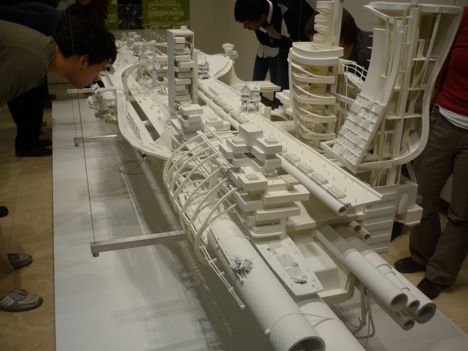
I attended the opening of the Terreform exhibit at the Daniels School of Architecture in Toronto in January, and intended to go back to photograph Mitchell Joachim's work when there were no crowds. It never happened, and upon seeing Designboom's pictures today, I thought I would put mine up as well.
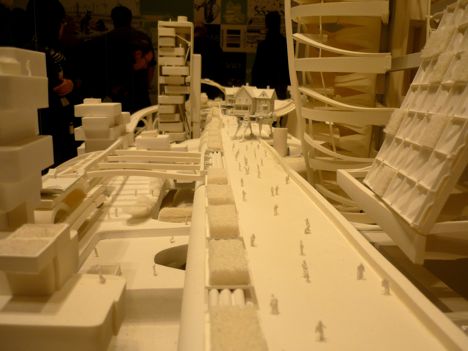
Joachim writes:
How can our cities extend into the suburbs sustainability? We propose to put our future American dwellings on wheels. These retrofitted houses will flock towards downtown city cores and back. We intended to reinforce our existing highways between cities with an intelligent renewable infrastructure. Therefore our homes will be enabled to flow continuously from urban core to core.
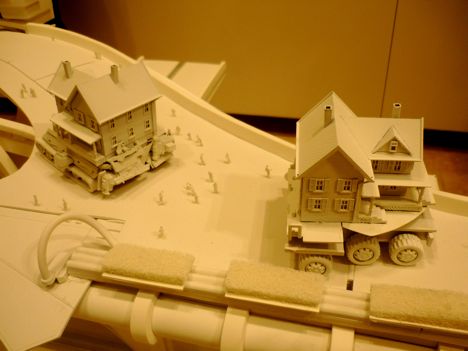
America has always been a nation on the road. We desire to move the suburbs on smart networked wheels. We intend to affix a diverse range of mobility mechanisms to home units that generate our novel HOMEWAY system. In the future, the physical home will remain permanent but its location will be transient. Our static suburbs will be transformed into a dynamic and deployable flow.
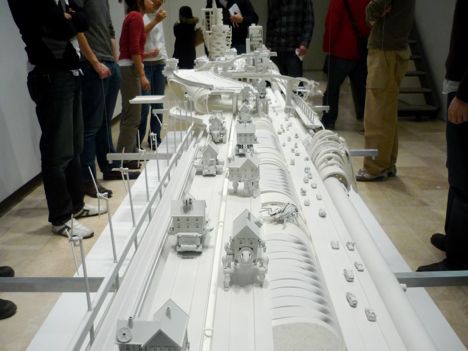
Houses will have the option to switch from parked to low speed. Homes, big box retail, movie theaters, supermarkets, business hubs, food production, and power plants will depart from their existing sprawled communities and line up along highways to create a truly breathing interconnected metabolic urbanism. Dense ribbons of food, energy, waste and water elements will follow the direction of moving population clusters.
-----
Via TreeHugger
Related Links:
Personal comment:
The strange meeting of the basic (and dystopian?) american suburb, sustainability (but is it really sustainable to move your house on highways? It's way bigger than a Hummer...) and Archigram utopias!
Tuesday, April 21. 2009
Sand/Stone
For an ambitious landscape design project, Magnus Larsson, a student at the Architectural Association in London, has proposed a 6,000km-long wall of artificially solidified sandstone architecture that would span the Sahara Desert, east to west, offering a combination of refugee housing and a "green wall" against the future spread of the desert.
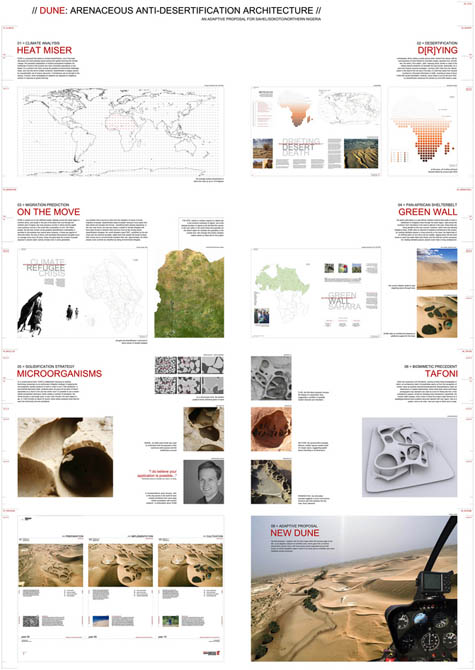 [Image: From Magnus Larsson's Dune: Arenaceous Anti-Desertification Architecture].
[Image: From Magnus Larsson's Dune: Arenaceous Anti-Desertification Architecture].
Larsson's project deservedly won first prize last fall at the Holcim Foundation's Awards for Sustainable Construction held in Marrakech, Morocco.
One of the most interesting aspects of the project, I think, is that this solidified dunescape is created through a particularly novel form of "sustainable construction" – that is, through a kind of infection of the earth.
In other words, Larsson has proposed using bacillus pasteurii, a "microorganism, readily available in marshes and wetlands, [that] solidifies loose sand into sandstone," he explains.
 [Image: From Magnus Larsson's Dune: Arenaceous Anti-Desertification Architecture].
[Image: From Magnus Larsson's Dune: Arenaceous Anti-Desertification Architecture].
Larsson points out the work of the Soil Interactions Lab at UC-Davis, which describes itself as "harnessing microbial activity to solidify problem soils."
But the idea of taking this research and applying it on a megascale – that is, to a 6,000km stretch of the Sahara Desert – boggles the mind. At the very least, the idea that this might be deployed for the wrong reasons, or by the wrong people, in some delirious hybrid of ice-nine, J.G. Ballard's The Crystal World, and perhaps a Roger Moore-era James Bond film, deserves further thought.
An epidemic of bacillus pasteurii infects all the loose sand in the world, forming great aerodynamic fins and waves in a kind of global Utah of glassine shapes.
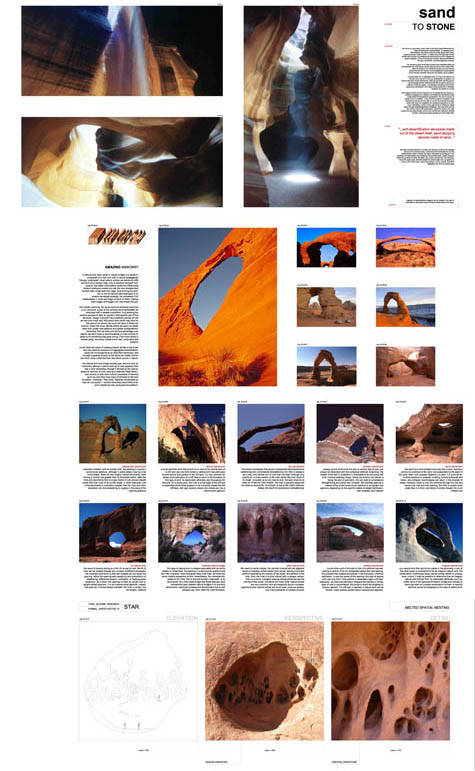 [Images: From Magnus Larsson's Dune: Arenaceous Anti-Desertification Architecture].
[Images: From Magnus Larsson's Dune: Arenaceous Anti-Desertification Architecture].
Clarifying the biochemical process through which his project could be realized, Larsson explained in a series of emails that his "structure is made straight from the dunescape by flushing a particular bacteria through the loose sand... which causes a biological reaction whereby the sand turns into sandstone; the initial reactions are finished within 24 hours, though it would take about a week to saturate the sand enough to make the structure habitable."
The project – a kind of bio-architectural test-landscape – would thus "go from a balloon-like pneumatic structure filled with bacillus pasteurii, which would then be released into the sand and allowed to solidify the same into a permacultural architecture."
 [Image: From Magnus Larsson's Dune: Arenaceous Anti-Desertification Architecture].
[Image: From Magnus Larsson's Dune: Arenaceous Anti-Desertification Architecture].
The "architectural form" of the resulting solidified sandscape is actually "derived from tafoni," Larsson writes, where tafoni is "a cavernous rock structure that formally ties the project back to notions of aggregation and erosion. On a conceptual scale, the project spans some 6,000km, putting it on a par with Superstudio's famous Continuous Monument – but with an environmental agenda."
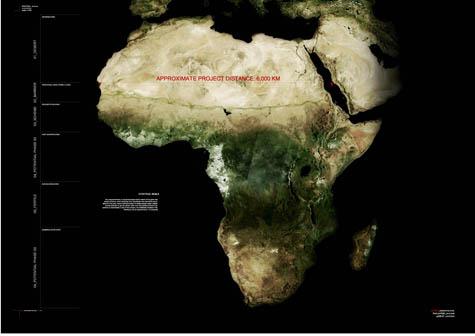
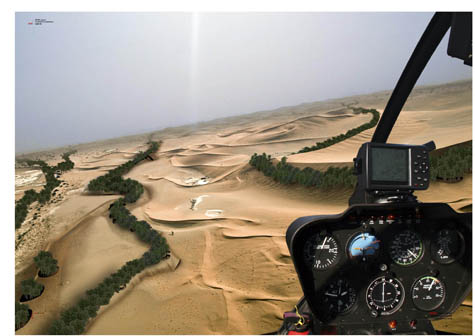 [Images: From Magnus Larsson's Dune: Arenaceous Anti-Desertification Architecture].
[Images: From Magnus Larsson's Dune: Arenaceous Anti-Desertification Architecture].
I'm reminded of Michael Welland's recent book Sand. There, Welland describes "how deserts operate" (he compares them to "engines" of mechanical weathering); he points out that you can still find "sand-sized fragments of steel" on the D-Day beaches of Normandy, war having left behind a hidden desert of metal; and he mentions that the UK now maintains "the world's first database of sand" – but that it's used "specifically for police forensics."
Welland's descriptions of sand dune physics are particularly memorable. He writes, for instance, that an avalanche is really a sand dune being "overwhelmed by the huge number of very small events" on its surface, and that these "very small events" unpredictably lead to one decisive moment of cascading self-collapse.
 [Image: A photomicrograph of sand grains].
[Image: A photomicrograph of sand grains].
Fantastically, though, and more relevant to this post, he then compares the internal structure of sand dunes to Gothic cathedrals: the grains of sand piled high form "microscopic chains and networks... in such a way that they carry most of the pressure from the weight of the material above them." This is the architecture of sand:
- These chains seem to behave like the soaring arches of Gothic cathedrals, which serve to transmit the weight of the roof, perhaps a great dome, outward to the walls, which bear the load.
Briefly, though, this image can be sustained through Welland's descriptions of the great ergs, or sand seas, of today. These dune seas "are tangibly mobile, ever changing," Welland writes, "but there are larger areas of ergs past that are now fixed by vegetation."
- Most of today's active sandy deserts are surrounded by vast stretches of old stabilized dunes, formed as the trade-wind belts and arid regions expanded in the cold, dry climate of the last ice age and immobilized as the climate changed. However, continuing shifts in the climate may bring these fixed ergs, granular reserves awaiting activation, back to life.
He mentions the Sand Hills of northwestern Nebraska, "formed originally from the debris of the glacial erosion of the Rocky Mountains."
- The hills were stabilized eight hundred years ago but have had episodes of reincarnation since: a long drought toward the end of the eighteenth century resuscitated dunes on the Great Plains, whose activity caused problems for the westbound wagon trains decades earlier.
But if sand dunes are Gothic cathedrals, and if those dunes can come back to life, the resulting image of resuscitated Gothic cathedrals moving slowly over the American landscape is almost too incredible to contemplate.
 [Images: From Magnus Larsson's Dune: Arenaceous Anti-Desertification Architecture].
[Images: From Magnus Larsson's Dune: Arenaceous Anti-Desertification Architecture].
Larsson's project descriptions maintain this somewhat hallucinatory feel:
- I researched different types of construction methods involving pile systems and realised that injection piles could probably be used to get the bacteria down into the sand – a procedure that would be analogous to using an oversized 3D printer, solidifying parts of the dune as needed. The piles would be pushed through the dune surface and a first layer of bacteria spread out, solidifying an initial surface within the dune. They would then be pulled up, creating almost any conceivable (structurally sound) surface along their way, with the loose sand acting as a jig before being excavated to create the necessary voids. If we allow ourselves to dream, we could even fantasise about ways in which the wind could do a lot of this work for us: solidifying parts of the surface to force the grains of sand to align in certain patterns, certain shapes, having the wind blow out our voids, creating a structure that would change and change again over the course of a decade, a century, a millenium.
A vast 3D printer made of bacteria crawls undetectably through the deserts of the world, printing new landscapes into existence over the course of 10,000 years...
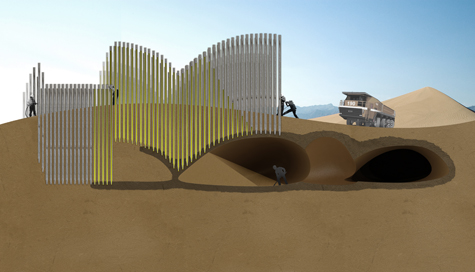 [Image: From Magnus Larsson's Dune: Arenaceous Anti-Desertification Architecture].
[Image: From Magnus Larsson's Dune: Arenaceous Anti-Desertification Architecture].
Larsson goes on to contrast his method with existing vernacular techniques of anti-desertification:
- Traditional anti-desertification methods include the planting of trees and cacti, the cultivation of grasses and shrubs, and the construction of sand-catching fences and walls. More ambitious projects have ventured into the development of agriculture and livestock, water conservation, soil management, forestry, sustainable energy, improved land use, wildlife protection, poverty alleviation, and so on. This project, apart from utilising a completely new way of turning sand into sandstone, incorporates all of the above. Inside the dunes, we can take care of our plants and animals, find water and shade, help the soil remain fertile, care for the trees, and so on. In this way, it's an environmental project that hopefully provides an innovation for other architects/builders to use and copy time and time again.
The following images show us the lab-based biochemical practices through which a landscape can be lithified. However, for me at least, these photos also come with the interesting implication that rogue basement chemists of the future won't be like Albert Hofmann or Ann & Alexander Shulgin; the heavily regulated underground rogue chemistry sets of the 21st century will instead synthesize new terrestrial compounds, counter-earths and other illegal geosimulants, rare earth anti-elements that might then catalyze a wholesale resurfacing of the world through radical landscape architecture.
Which leads me to ask: where is landscape architecture's Aleister Crowley, Madame Blavatsky, or even John Dee? Mystics of terrestrial form, hacking the periodic table of the elements inside makeshift labs.
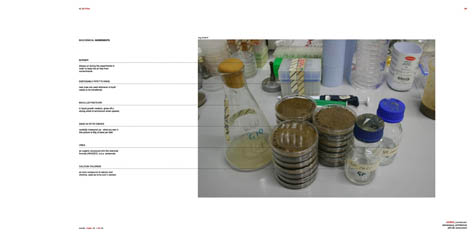

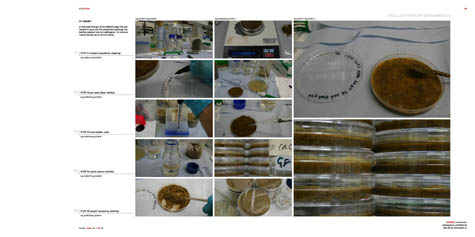 [Images: Synthesizing rare earth compounds – bioterrestriality; from Magnus Larsson's Dune: Arenaceous Anti-Desertification Architecture].
[Images: Synthesizing rare earth compounds – bioterrestriality; from Magnus Larsson's Dune: Arenaceous Anti-Desertification Architecture].
In any case, Larsson's "solidified dunes," we read, would also "support the existing Green Wall Sahara initiative: 24 African countries coming together to plant a shelterbelt of trees right across the continent, from Mauritania in the west to Djibouti in the east, in order to mitigate against the encroaching desert."


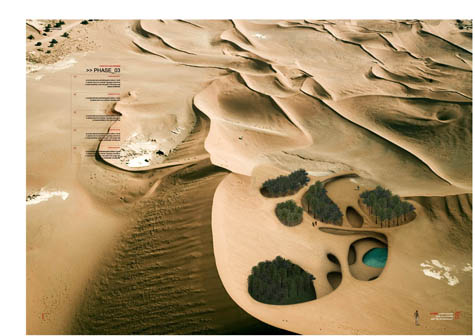 [Images: From Magnus Larsson's Dune: Arenaceous Anti-Desertification Architecture].
[Images: From Magnus Larsson's Dune: Arenaceous Anti-Desertification Architecture].
Clearly having thought through the project in extraordinary detail, Larsson then points out that the structure itself would generate a "temperature difference between the interior of the solidified dunes and the exterior dune surface." This then "makes it possible to start building a permacultural network, the nodal points of which would support water harvesting and thermal comfort zones that can be inhabited."
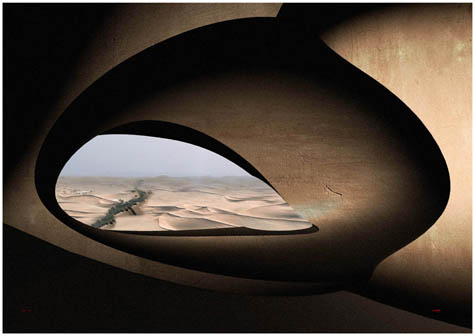 [Image: The view from within; from Magnus Larsson's Dune: Arenaceous Anti-Desertification Architecture].
[Image: The view from within; from Magnus Larsson's Dune: Arenaceous Anti-Desertification Architecture].
Eventually, then, a 6000km-long wall of permaculturally active, inhabited architecture will span the Sahara.
Check out more images in this Flickr set for the project, or read a bit more about the project over at the Holcim Foundation.
-----
Via BLDBLOG
Related Links:
Personal comment:
Un de ces projets qui participent d'une nouvelle tendance d'"architecture-territoire" (et qui n'a pas forçément besoin de s'étaler à l'échelle du territoire, contrairement à ce projet).
Tuesday, March 10. 2009
Wanting to Be You
-----
Via WMMNA
Related Links:
Personal comment:
Sorte d'habit pour activiste médiatique. Homme/Femme sandwich revisité/e façon début de XXIème.
Wednesday, December 10. 2008
Plectic Architecture
*I'm trying to imagine myself old, and feeble, and weak, and sick, and white-haired, and totally surrounded by mid-21C "Plectic Architecture."
Obviously I've got it coming, I deserve that fate, but... maybe I'd be really *pleased and serene*. "Yes, this part is nanotechnological... and this is an old-skool Janine Benyus biomimicry riff here... and this useless Koolhaas junkspace where I keep my dialysis unit, that's where they goofed off doing Rhinoscript 'taffypulling.'"
And then I take visitors over to the BDLGBLOG room where I've got a crumbling archive of the only stuff every physically printed out from BLDGBLOG. It's like Tut's tomb in there. It's like Otzi's autopsy table, and a cloud of plectic dry-ice pours out whenever I open it.
http://www.bartlett.ucl.ac.uk/otherhostedsites/avatar/intro.html
PLECTIC ARCHITECTURE -TOWARDS A THEORY OF THE POST-DIGITAL IN ARCHITECTURE (((no no, don't run away yet -- it's pretty good stuff, and I put some paragraphs in it so it's almost parseable)))
Definitions:
Firstly it is important to stress that "Post-Digital Architecture" is not an architecture without any digital component. Indeed it an architecture that very much is a synthesis between the virtual, the actual, the biological, the cyborgian, the augmented and the mixed.
It is impossible, anymore, to talk of Digital Architecture as a binary opposition to normal real world architecture. Cyberspace has insidiously insinuated itself into our existence, at every scale and at every turn. (((Yep.)))
Murray Gell-Mann defines "Plectics" as the "...the study of simplicity and complexity. It includes the various attempts to define complexity; the study of roles of simplicity and complexity and of classical and quantum information in the history of the universe, the physics of information; the study of non-linear dynamics, including chaos theory, strange attractors, and self-similarity in complex non-adaptive systems in physical science; and the study of complex adaptive systems, including prebiotic chemical evolution, biological evolution, the behaviour of individual organisms, the functioning of ecosystems, the operation of mammalian immune systems, learning and thinking, the evolution of human languages, the rise and fall of human cultures, the behaviour of markets, and the operation of computers that are designed or programmed to evolve strategies - say, for playing chess, or solving problems." (1)
If we start to think of the architecture in this book (((there's a book? Hey wait, wow, I need that book))) as the first stirrings of a Plectic post-digital Architecture, then Murray Gell-Mann's, mid nineteen eighties definition, of "Plectics" seems a suitably broad umbrella within which to situate it.
Such terrain can include a variety of complex sub cultures of architecture that are all composed of differing degrees of the digital, the virtual, the biological and the nanotechnological, interaction and reflexivity without banishing the more off piste and often less fashionable investigations, propositions and researches.
Above all these architectures seek to simplify, amplify or facilitate and make visible the complex entanglement of contemporary space. (((And that's a full day's work right there, folks.)))
-----
Via Beyond the beyond (Bruce Sterling)
Related Links:
Personal comment:
Bruce Sterling relate l'évolution du M-Arch "AVATAR --pour Advanced Virtual And Technological Architecture Research--" de la Bartlett School of Architecture de Londres (un très bon cursus): le master passe au "post-digital", non pas parce qu'il n'y a plus de digital, bien au contraire, mais parce "qu'il n'y a plus de distinction binaire possible entre digital et physique, virtuel et actuel, etc."
"Les éléments sont dorénavants entremélés" et le master vise à "une architecture qui cherche la synthèse entre le virtuel, l'actuel, le biologique, le cybernétique, l'augmenté et le mixte."
C'est ce que l'on disait déjà en 1999 avec le projet La_Fabrique, mais que l'on a commencé à réaliser "seulement" en 2001 avec Electroscape 001... Aujourd'hui nous parlons pour notre part plutôt d'"interférences spatiales", d"ex-dimensionnalité" et de "temporalités ou réalités post-globales", voir de "réel hallucinant (psychédélique)", ... plutôt que de "plectisme"! ;)
Tuesday, February 07. 2006
"Variable Environment / Interaction City & Crossovers", Tracés 18 – Design & Matériaux (Zürich – Écublens, 2004)
Monday, February 06. 2006
"Digital BM, map_IT, Electroscape 002", Tracés 17 – Pensionnat numérique (Zürich – Écublens, 2003)
fabric | rblg
This blog is the survey website of fabric | ch - studio for architecture, interaction and research.
We curate and reblog articles, researches, writings, exhibitions and projects that we notice and find interesting during our everyday practice and readings.
Most articles concern the intertwined fields of architecture, territory, art, interaction design, thinking and science. From time to time, we also publish documentation about our own work and research, immersed among these related resources and inspirations.
This website is used by fabric | ch as archive, references and resources. It is shared with all those interested in the same topics as we are, in the hope that they will also find valuable references and content in it.
Quicksearch
Categories
Calendar
|
|
July '25 | |||||
| Mon | Tue | Wed | Thu | Fri | Sat | Sun |
| 1 | 2 | 3 | 4 | 5 | 6 | |
| 7 | 8 | 9 | 10 | 11 | 12 | 13 |
| 14 | 15 | 16 | 17 | 18 | 19 | 20 |
| 21 | 22 | 23 | 24 | 25 | 26 | 27 |
| 28 | 29 | 30 | 31 | |||


